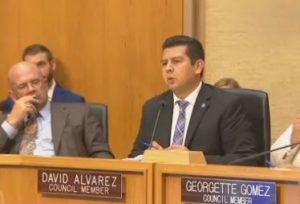SAN DIEGO, Calif. — The San Diego City Council unanimously declared a shelter crisis Monday in an 8-0 vote as it related to the Hepatitis A outbreak that has killed 17 people, most of whom were homeless.
Mayor Kevin Faulconer endorsed the action, saying it would help in setting up three temporary shelters for the homeless soon in the Midway District, downtown and Barrio Logan.
“Declarations like this are very important,” said Faulconer, who was the first speaker at the City Council meeting. He pledged his “strong support for today’s resolution.”
The Republican mayor said this disease has taken “too many lives.” He said cities have to do more, adding “we are all in this together. The eyes of the nation are upon us.”
 Third District Councilmember Christopher Ward made the motion for the declaration which was seconded by Councilmember David Alvarez, which is an update to an earlier declaration. “This gives complete authority for the mayor to act,” said Alvarez.
Third District Councilmember Christopher Ward made the motion for the declaration which was seconded by Councilmember David Alvarez, which is an update to an earlier declaration. “This gives complete authority for the mayor to act,” said Alvarez.
Alvarez said he wanted the city to consider bringing the homeless into the former downtown library, Golden Hall, the former training facility of the Chargers and the SDCCU Stadium.
San Diego County issued a declaration of a local health emergency Sept. 1 after 15 people had died. The outbreak here is the highest fatality rate in the nation with 461 people diagnosed with Hepatitis A, which is spread from person-to-person contact or consumption of contaminated food or water.
So far 66 hand washing stations have been erected in various parts of the city and more portable restrooms have become available, including four outside City Hall with two washing stations.
Faulconer ordered extensive sidewalk power washing Sept. 11 with water and bleach in various parts of the city including Pacific Beach, Ocean Beach, downtown, North Park and other areas. The sidewalks have been very dirty and not been cleaned like this in years.
So far 315 people of 461 confirmed cases have been hospitalized with Hepatitis A. The youngest victim was five years old and the oldest was 87 years of age, according to new statistics. The 17 deaths represent 3.7 percent of people with the disease.
Approximately 63 percent of victims were either homeless or drug users, but there were 173 people sickened who were not in either category and how they became infected is unknown. So far, 69 percent of victims were male and 31 percent female.
The county reported Sept. 11 at least two victims were gay. The San Diego Union-Tribune reported Oct. 1 the known number of gay males with Hepatitis A had risen to eight.
More than 43,000 residents have been immunized against Hepatitis A after free vaccination clinics were set up in several locations. In 2016, there were only 26 documented cases of Hepatitis A here.
Recent figures show there are 9,116 people who are homeless in the region, with 5,619 people within San Diego city limits. This includes 2,388 people who are housed in emergency shelters or transitional housing. There has been a 58% increase in the number of people sleeping in tents or hand-built structures since last year, according to city records.
Councilmember Scott Sherman thanked Ward for bringing the declaration forward, saying it will make it easier to set up temporary homeless shelters past regulations. He said homeless shelters should be in all council districts.
“We need other cities to step up,” said Councilmember Lorie Zapf. “If you Google us, we’re the best place to be homeless.”
The other two locations where emergency shelters will be set up in tents are 14th and Commercial Streets in downtown, and another in Barrio Logan. Councilmember Chris Cate was absent.
There were five public speakers in favor of the resolution including David Ross, who is known as “The Water Man” who distributes bottled water to homeless people. Ross told the Council the disease was preventable.
The only speaker opposed to the resolution was Hud Collins who said it didn’t go far enough. Collins said the city should suspend all criminal and civil laws and “get everybody off the street.” He said the crisis is similar “as if we were hit with a hurricane.”
The virus is spread from sexual contact with someone with the illness, ingestion of fecal matter even in microscopic amounts, recreational drug use, touching objects that were handled with an infected person, or eating food that had been handled by someone with the disease.
The virus can live outside the body for months which is why the power washing of sidewalks was ordered. The average incubation period is 28 days and people can be contagious up to two weeks before symptoms such as a fever or jaundice develops.
Ironically, a medical conference on infectious disease will start in San Diego on Wednesday at the Convention Center.











